Mythology significantly influences apocalyptic narratives by shaping archetypes and motifs that resonate across cultures. These narratives reflect societal anxieties and hopes, illustrating cycles of destruction and renewal. Various mythological interpretations reveal diverse cultural values and existential themes. Modern adaptations emphasize individual struggles, contrasting with traditional focuses on collective fate.
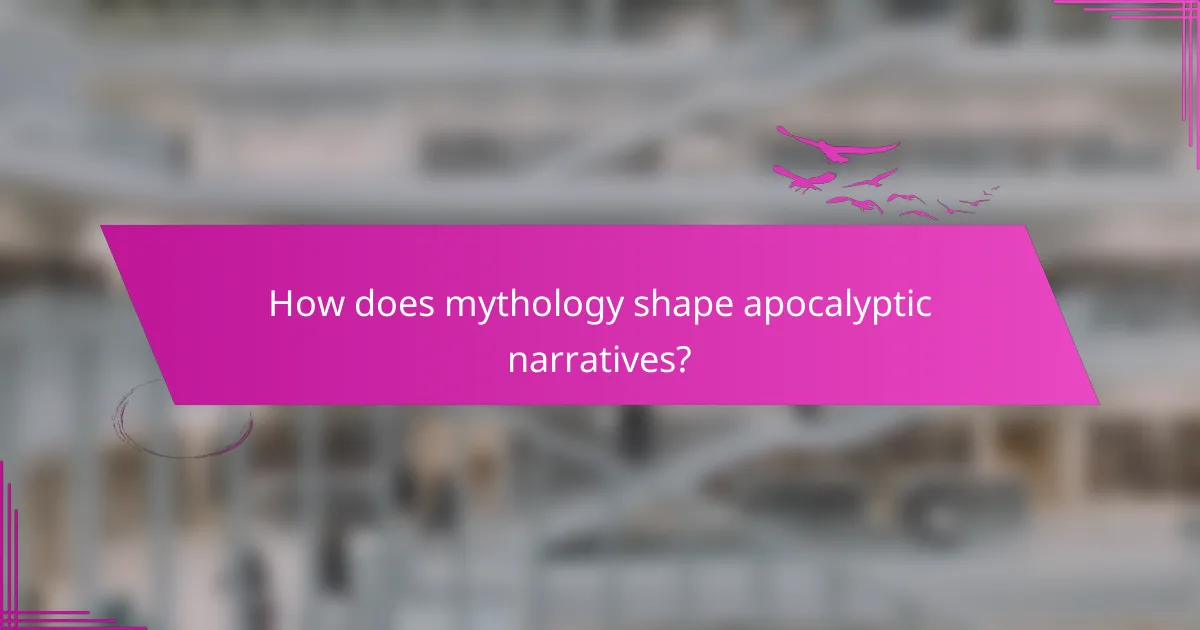
How does mythology shape apocalyptic narratives?
Mythology profoundly shapes apocalyptic narratives by providing archetypes and motifs that resonate across cultures. These narratives often reflect humanity’s fears and hopes, illustrating cycles of destruction and renewal. For instance, the flood myth appears in various traditions, symbolising both divine judgement and rebirth. Mythological figures, such as saviours or harbingers of doom, serve to convey moral lessons and existential truths. The unique attribute of mythology lies in its ability to adapt and evolve, influencing modern interpretations of apocalypse in literature and film. As a result, these narratives continue to engage audiences, reflecting societal anxieties and aspirations.
What are the common archetypes found in apocalyptic myths?
Common archetypes in apocalyptic myths include the hero, the saviour, the destroyer, the trickster, and the survivor. These archetypes shape narratives and reflect cultural fears and hopes. The hero often embodies resilience, while the saviour represents redemption. The destroyer signifies chaos and transformation, and the trickster challenges norms, introducing uncertainty. Finally, the survivor symbolizes endurance and adaptability in the face of catastrophe. Each archetype plays a critical role in conveying the underlying themes of human experience during apocalyptic events.
Which motifs recur in various cultural interpretations of apocalypse?
Common motifs in cultural interpretations of apocalypse include destruction, rebirth, and moral reckoning. These themes reflect humanity’s fears and hopes regarding endings and new beginnings. Destruction often symbolizes societal collapse, while rebirth represents hope for renewal and transformation. Moral reckoning serves as a reminder of ethical consequences in the face of catastrophic events. Each culture adapts these motifs to its unique historical and social context, creating diverse yet interconnected narratives.
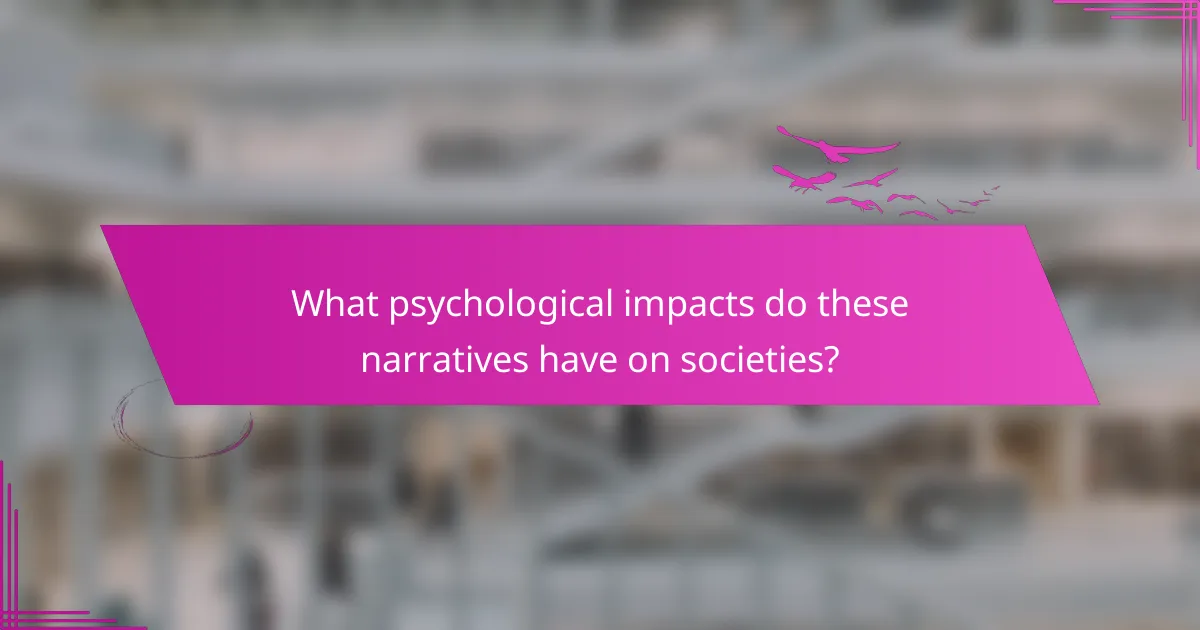
What psychological impacts do these narratives have on societies?
Apocalyptic narratives significantly influence societies by shaping collective beliefs and behaviours. These stories often evoke fear, hope, and a sense of urgency, impacting societal responses to current crises.
Mythological archetypes, such as the hero or the saviour, reinforce cultural values and provide frameworks for understanding existential threats. As a result, these narratives can unify communities or incite conflict, depending on their interpretations.
Moreover, the motifs present in apocalyptic tales, like rebirth or destruction, can lead to psychological resilience or despair. Societies may either rally around a shared vision of renewal or succumb to fatalism, affecting social cohesion and mental health.
In summary, the psychological impacts of apocalyptic narratives are profound, influencing how societies perceive threats and respond to change.
How do different cultures perceive the end of the world?
Different cultures perceive the end of the world through diverse mythological narratives that shape their beliefs and expectations. Archetypal figures and motifs, such as floods, fire, and celestial events, frequently appear across cultures. For example, the Great Flood in various traditions symbolizes divine judgement and renewal. Interpretations of these narratives reflect unique cultural values and historical contexts, influencing how societies prepare for or respond to apocalyptic scenarios. This interplay between mythology and cultural perception creates a rich tapestry of beliefs surrounding the end of the world.
What role does fear play in shaping apocalyptic beliefs?
Fear significantly influences apocalyptic beliefs by shaping narratives that resonate with human anxieties. It often amplifies themes of destruction and renewal found in mythology. For instance, archetypes of the hero and the end of times reflect deep-seated fears of loss and transformation. As a result, these narratives can serve as both warnings and sources of hope, allowing individuals to navigate their uncertainties. The interplay of fear and mythology creates compelling stories that reflect societal concerns, making them powerful tools for understanding human behaviour in the face of potential catastrophe.
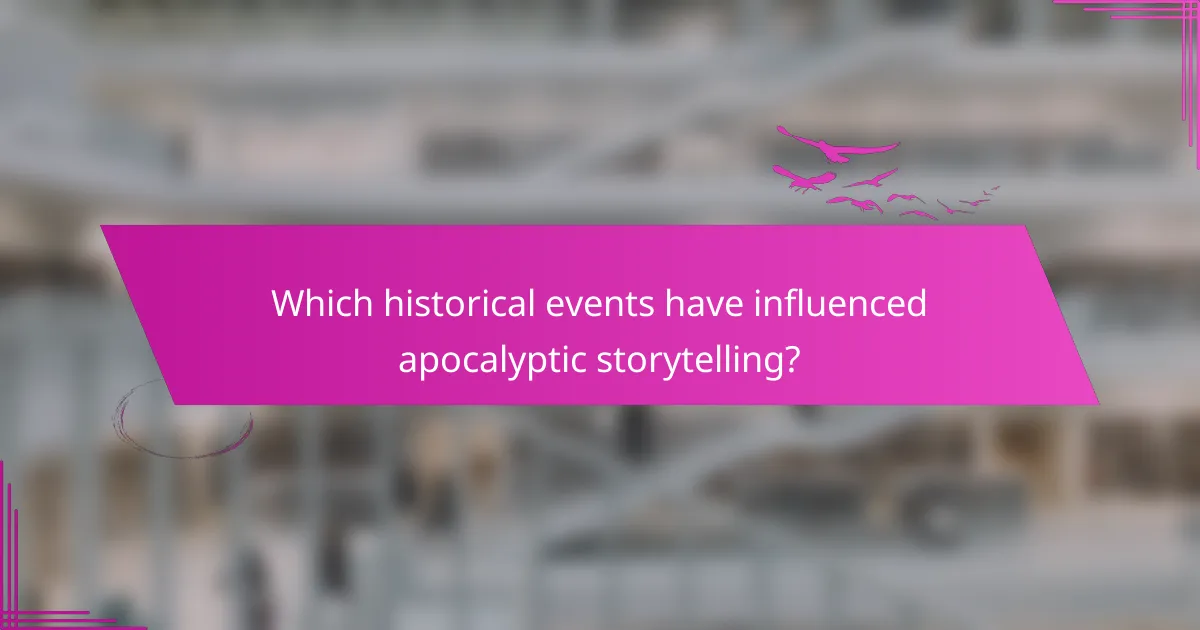
Which historical events have influenced apocalyptic storytelling?
Mythology has profoundly shaped apocalyptic storytelling through archetypes, motifs, and interpretations. Various historical events, such as natural disasters and societal upheavals, have inspired narratives of destruction and rebirth. For example, the fall of empires often correlates with themes of divine judgement found in myths. Additionally, cultural beliefs about the end of the world, like those in the Norse Ragnarok or the Christian Revelation, reflect societal anxieties and hopes. These stories serve as a lens through which communities process existential fears and envision renewal.
How did the Cold War shape modern apocalyptic narratives?
The Cold War significantly influenced modern apocalyptic narratives by embedding themes of fear, distrust, and existential threat. This era introduced archetypes such as the “nuclear apocalypse,” reflecting societal anxieties about nuclear warfare. These narratives often feature motifs of survival and redemption, echoing the struggles faced during this period. Interpretations of apocalyptic scenarios have since evolved, incorporating elements of mythology and cultural fears, demonstrating how historical contexts shape our understanding of potential futures.
What is the impact of climate change on contemporary apocalyptic themes?
Climate change significantly influences contemporary apocalyptic themes by reshaping narratives through environmental degradation and societal collapse. Mythological archetypes, such as the flood or fire, re-emerge, reflecting humanity’s fears about climate-induced disasters. These narratives often highlight the struggle between nature and civilization, emphasizing the consequences of neglecting ecological balance. For instance, modern interpretations depict climate change as a catalyst for societal breakdown, resonating with ancient myths of destruction and rebirth. This connection reveals a unique attribute of contemporary storytelling, where ancient motifs adapt to address current existential threats.
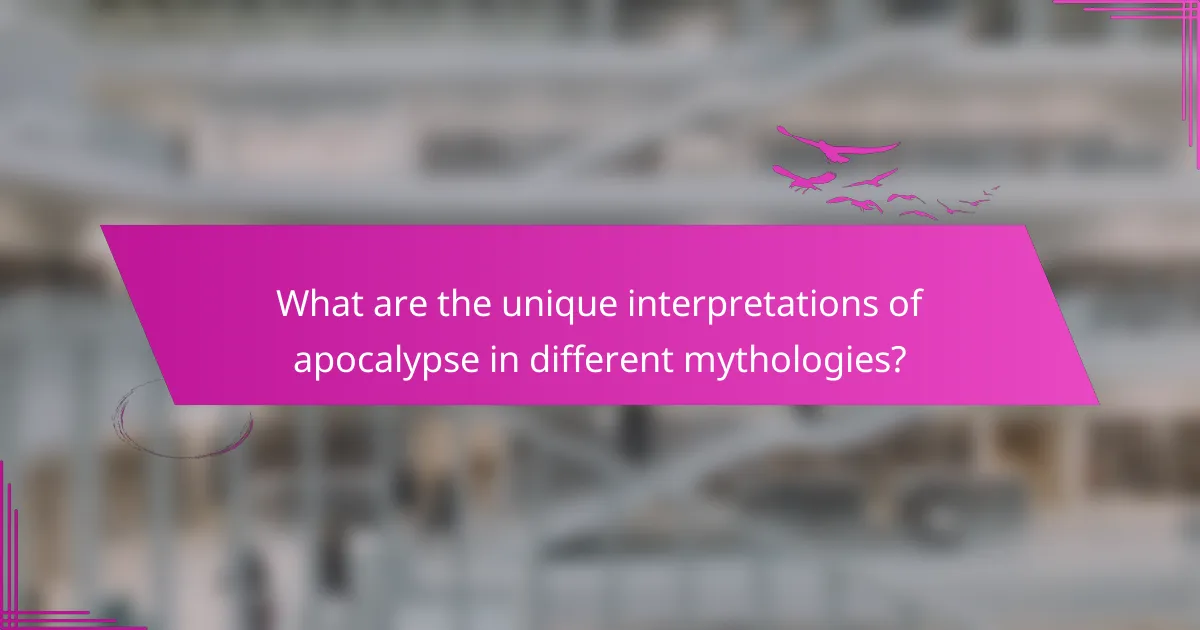
What are the unique interpretations of apocalypse in different mythologies?
Different mythologies interpret the apocalypse through unique narratives, often reflecting cultural values and existential themes. In Norse mythology, Ragnarok signifies a cyclical destruction and rebirth, emphasizing renewal. Christianity presents a linear apocalypse with a final judgement, focusing on moral accountability. Hinduism features cycles of creation and destruction, highlighting the eternal nature of the universe. Ancient Egyptian mythology describes a judgement in the afterlife, stressing the importance of moral deeds. These interpretations reveal diverse perspectives on endings and beginnings, shaped by the respective cultures’ beliefs and philosophies.
How does Norse mythology depict the end times?
Norse mythology depicts the end times through the concept of Ragnarök, a series of events leading to the world’s destruction. Key archetypes include gods like Odin and Thor, who engage in battles against giants and monsters. The motifs of fate and rebirth are central, showcasing a cyclical nature of existence. Interpretations often highlight themes of inevitability and the struggle between order and chaos, reflecting cultural anxieties about mortality and change.
What are the distinctive features of Hindu apocalyptic narratives?
Hindu apocalyptic narratives feature cycles of creation and destruction, emphasizing cosmic order. Key elements include the concept of time as cyclical and the role of deities like Vishnu in preserving and restoring balance. Unique attributes involve the interplay of karma and dharma, influencing the narrative’s moral framework. Rare motifs, such as the Kalki avatar, symbolize the ultimate restoration of righteousness. These narratives reflect deep philosophical insights about existence and the universe’s nature.
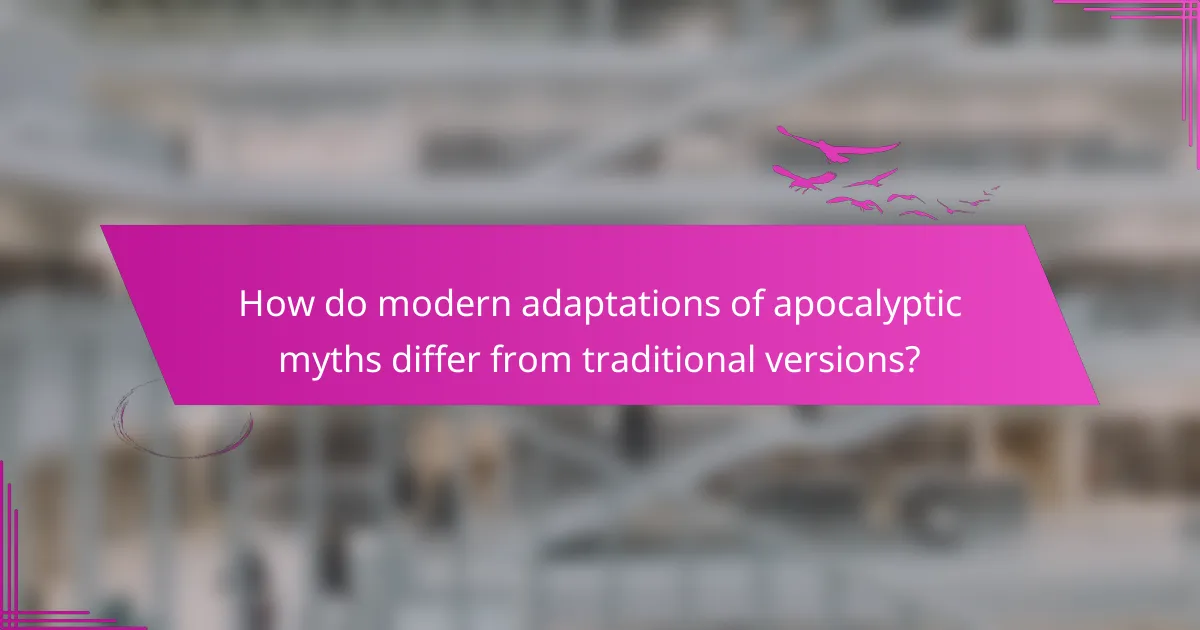
How do modern adaptations of apocalyptic myths differ from traditional versions?
Modern adaptations of apocalyptic myths often emphasize individualism and existential themes, contrasting with traditional versions that focus on collective fate. Contemporary narratives frequently explore personal struggles and moral dilemmas, reflecting modern societal anxieties. Traditional myths typically emphasize divine judgement and cosmic order, whereas modern interpretations often question authority and highlight human agency. This shift reveals a unique attribute of contemporary storytelling: the focus on psychological depth over mythic archetypes. As a result, adaptations resonate with audiences facing complex modern realities.
Which contemporary media portray these narratives effectively?
Contemporary media portray apocalyptic narratives influenced by mythology through films, literature, and television series. Notable examples include “The Road,” which explores survival themes, and “American Gods,” showcasing mythological archetypes. “Children of Men” presents a dystopian future reflecting societal fears. Each effectively employs motifs like destruction and rebirth, resonating with audiences.
What are the implications of reinterpreting ancient myths in today’s society?
Reinterpreting ancient myths in today’s society can reshape cultural narratives and influence modern beliefs. These reinterpretations often reflect current societal values and concerns, such as environmental issues or social justice. By examining archetypes and motifs within myths, contemporary audiences can draw parallels to their own experiences, fostering a deeper understanding of human nature and existential themes. This dynamic interplay between ancient stories and modern contexts can inspire new interpretations of apocalyptic narratives, emphasizing resilience and hope amidst chaos.
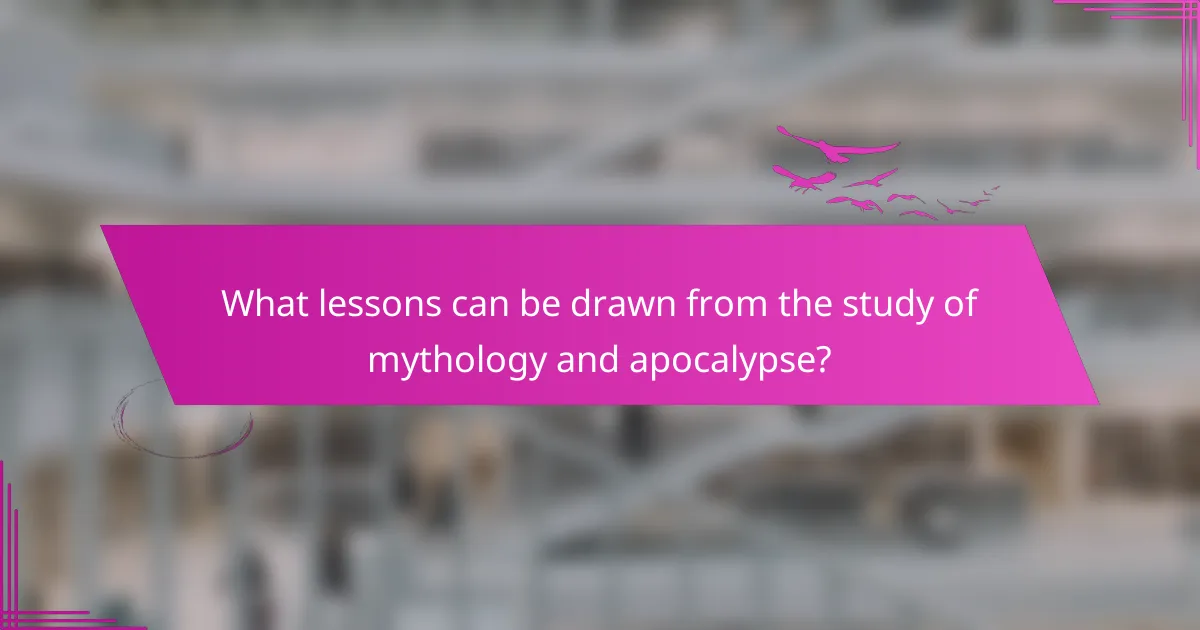
What lessons can be drawn from the study of mythology and apocalypse?
The study of mythology reveals significant lessons about human behaviour and societal values in apocalyptic narratives. Mythological archetypes, such as the hero’s journey, illustrate how individuals confront chaos and uncertainty. These narratives often reflect cultural fears and hopes, shaping interpretations of potential futures. Additionally, motifs like rebirth and transformation highlight resilience in the face of destruction. By analyzing these elements, we understand how mythology informs our perceptions of endings and new beginnings, guiding collective responses to existential threats.
How can understanding these narratives help in addressing current global crises?
Understanding these narratives can reveal underlying patterns in human behaviour and societal responses to crises. Mythology often reflects collective fears and hopes, shaping how communities perceive impending disasters. By analyzing archetypes and motifs in apocalyptic narratives, we can identify recurring themes that resonate across cultures. This insight can guide effective communication strategies and foster resilience in the face of global challenges. Moreover, interpretations of these narratives can inspire innovative solutions, encouraging collaboration and unity among diverse groups. Thus, mythology serves as a valuable lens for addressing contemporary crises.
What best practices can be applied when analyzing apocalyptic themes in literature?
To analyze apocalyptic themes in literature effectively, focus on the interplay of mythology and archetypes. Consider the following best practices:
1. Identify recurring archetypes that shape apocalyptic narratives, such as the hero, the saviour, or the destroyer.
2. Examine motifs like destruction, rebirth, and moral decline to understand their significance in the context of mythology.
3. Explore interpretations of myths that reflect societal fears and hopes regarding the end of the world.
4. Analyze how different cultures utilize mythology to convey unique apocalyptic visions, revealing diverse perspectives.
5. Contextualize the narratives within historical and cultural frameworks to uncover deeper meanings and implications.
